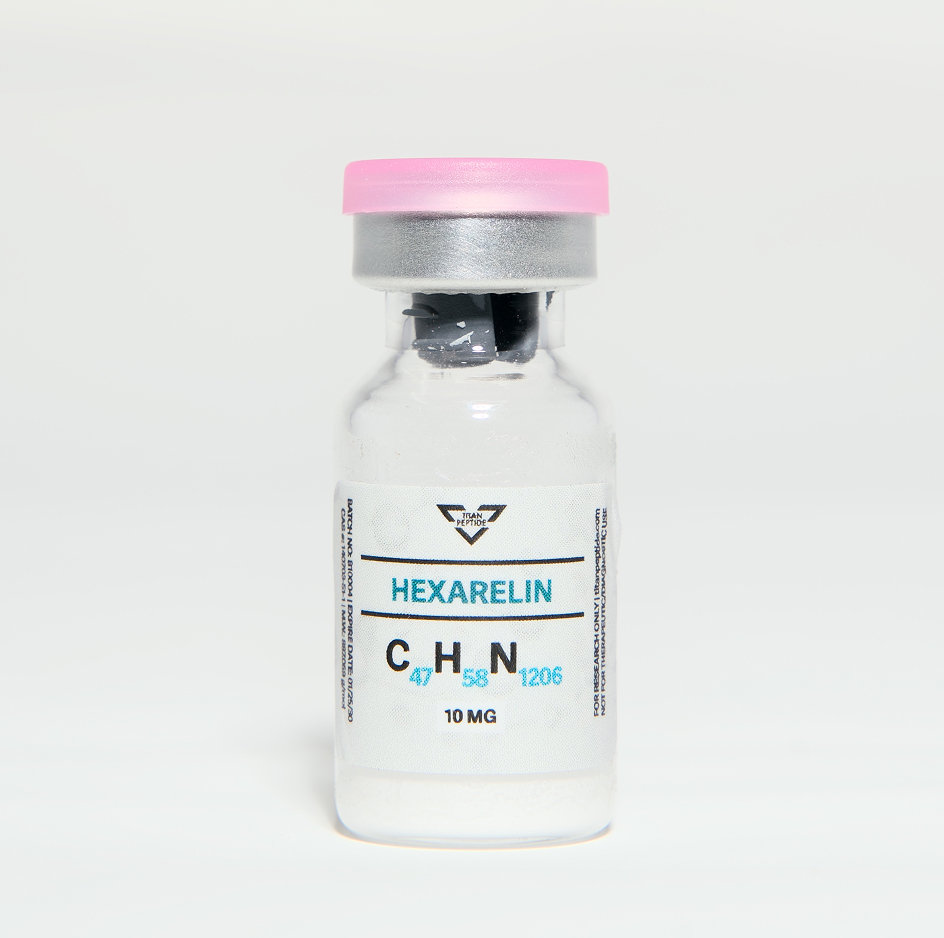

HEXARELIN
Hexarelin is a synthetic hexapeptide and a potent agonist of the ghrelin receptor (GHSR-1a), designed to stimulate growth hormone (GH) release from the anterior pituitary. It belongs to the GHRP family but is recognized as one of the most potent members for GH release in experimental models.





A synthetic growth hormone–releasing peptide (GHRP) analog modeled for laboratory research.
Hexarelin is a synthetic hexapeptide and a potent agonist of the ghrelin receptor (GHSR-1a), designed to stimulate growth hormone (GH) release from the anterior pituitary. It belongs to the GHRP family but is recognized as one of the most potent members for GH release in experimental models.
In research models, CJC-1295 is studied for its effects on metabolism, body composition, recovery, and repair processes. Its extended activity makes it particularly useful for investigating long-term growth hormone modulation without frequent administration.

Titan research and immune system function
Growth Hormone Release:
Investigated for its strong and sustained ability to elevate GH levels in experimental models.
Muscle Growth & Repair:
Studied for potential anabolic effects, supporting lean muscle mass development and recovery.
Fat Metabolism:
Research explores its role in enhancing lipolysis and reducing fat mass.
Cardioprotective Effects:
Preclinical studies suggest Hexarelin may protect cardiac tissue and improve heart function.
Synergistic Peptide Studies:
Often examined in combination with GHRH analogs (e.g., MOD GRF 1-29) to amplify GH release.
Titan research and immune system function
Pituitary Direct Stimulation:
Binds to ghrelin receptors in the pituitary to trigger potent GH release.
Metabolic Pathway Modulation:
Enhances fat utilization and supports nutrient partitioning in experimental models.
Tissue Protection:
Studies suggest potential benefits for myocardial protection and vascular health.
(1) Bowers, C. Y., et al. (1997). Hexarelin, a synthetic growth hormone-releasing peptide, stimulates GH release in humans. → Reported robust GH pulse stimulation within days, with continued secretion support through weeks. [Journal of Clinical Endocrinology & Metabolism, 82(9), 2950–2956]
(2) Ghigo, E., et al. (1999). Growth hormone-releasing peptides and their therapeutic potential. → Describes Hexarelin’s sustained effects on GH and IGF-1, along with cardioprotective and recovery benefits.
(3) Arvat, E., et al. (2001). Endocrine activities of Hexarelin in normal and GH-deficient subjects. → Found consistent improvements in GH output and muscle repair signals over 2–4 weeks.
.svg)
The graph demonstrates the effect of Hexarelin on growth hormone secretion and recovery functions over four weeks, combining human and animal data. At Week 1, the increase is already notable at 22%, showing that the compound acts early. By Week 2, the rise accelerates to 38%, highlighting progressive enhancement in hormone activity and recovery.
By Week 4, the effect reaches 55%, reflecting a strong cumulative impact. This suggests Hexarelin may be valuable for protocols aimed at boosting GH output and supporting recovery when sustained over multiple weeks.
Form:
Lyophilized Powder
Storage (unreconstituted):
- Store at 2–8 °C (refrigerated), protected from light.
- For long-term storage, keep at –20 °C.
- Avoid repeated freeze–thaw cycles.
Reconstitution:
- Reconstitute with sterile water for injection or 0.9% NaCl immediately prior to use. Use aseptic technique.
Storage (after reconstitution):
- Store at 2–8 °C.
- Use within 7–10 days.
- Discard any unused solution after this period.
- Handle under sterile conditions.
- Do not shake vigorously (may cause peptide denaturation).
- Inspect visually for particulate matter or discoloration before use.
Issued for quality verification of tested material.
Feedback highlighting proven outcomes and reliability.













